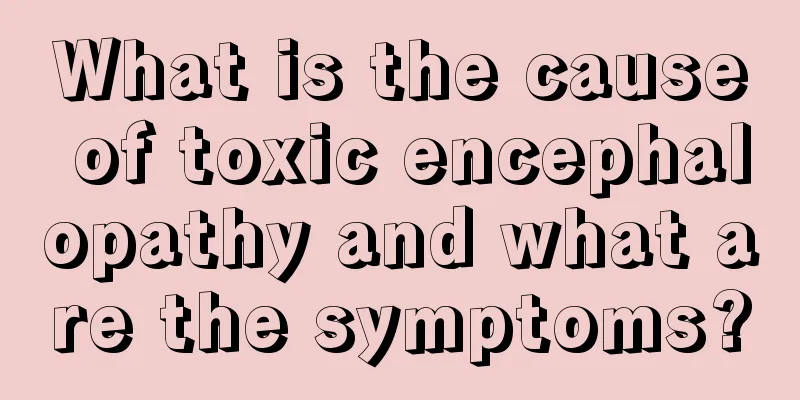What is the cause of toxic encephalopathy and what are the symptoms?

|
Toxic encephalopathy causes great harm to human health, so understanding the causes of toxic encephalopathy and preventing it has become people's top priority. So what are the causes of toxic encephalopathy in daily life? Let’s take a closer look at it below! Causes Acute bacterial infection is the main cause of the disease, such as sepsis, pneumonia, dysentery, typhoid fever, scarlet fever, diphtheria, pyelonephritis, etc., followed by acute respiratory infections caused by influenza virus, parainfluenza virus, syncytial virus, adenovirus and malaria can also cause the disease. Toxemia, metabolic disorders and hypoxia are also major pathogenesis. There are two main types of industrial poisons that can cause acute toxic encephalopathy. Neurotropic poison 1. Metals, metalloids and their compounds Such as lead, manganese, mercury, thallium, arsenic, tetraethyl lead, carbonyl nickel, trialkyltin, etc. Metals damage the function and structure of nerve cells by inhibiting enzymes, interfering with trace elements, affecting the water and electrolyte balance of cells, energy metabolism, and disrupting central nervous system mediators. 2. Solvent Such as benzene, toluene, xylene, gasoline, styrene, carbon disulfide, ethylene dichloride, trichloroethylene, carbon tetrachloride, methanol, chloroethanol, butyl acetate, ethylene oxide, etc. Organic solvents can dissolve in lipids in the central nervous system, changing the permeability of the blood-brain barrier and nerve cells and damaging nerve cells. 3. Halogenated hydrocarbons Such as methyl bromide, methyl chloride, etc. 4. Pesticides For example, organophosphorus pesticides, organochlorine pesticides, and organofluorine pesticides are all strong neurotropic poisons. Asphyxiating poison Causes brain tissue hypoxia. Such as carbon monoxide, cyanide, hydrogen sulfide, benzene amino, nitro compounds, carbon dioxide, methane, nitrogen, etc., which cause brain tissue hypoxia and can cause severe cerebral edema through reactive cerebrovascular changes and cell membrane sodium and potassium pump disorders. The above poisons can cause various pathological changes in the central nervous system through direct damage and hemodynamic disorders. Symptoms Acute onset It often occurs at the peak stage of serious infections such as toxic dysentery, sepsis, and severe pneumonia. Sudden encephalitis symptoms On the basis of the primary disease, encephalitis-like manifestations suddenly appear, such as drowsiness, delirium, coma, convulsions, central paralysis, decerebrate rigidity, pyramidal tract signs, etc., and fundus examination may show papilledema. Brain symptoms may subside within 1 to 3 days without leaving any sequelae. However, in severe cases or when not properly treated, they may rapidly worsen, often with sequelae of neurological damage. |
<<: What are ovaries and what foods can protect them
Recommend
Why do people feel sleepy in spring?
There is a saying that people feel sleepy in spri...
What are the treatments for ovarian cancer?
Suffering from ovarian cancer is undoubtedly a gr...
What are the effects and functions of turmeric powder?
The effects and functions of turmeric powder incl...
What are the treatments for lymph nodes?
If a disease such as lymph node disease occurs, t...
What's wrong with sagging eye bags
Many people have bags under their eyes, and the c...
What diet can prevent prostate cancer
Everyone should have a certain understanding of t...
Is ependymoma a glioma?
Ependymoma is a tumor that originates from the ve...
Is it necessary to remove the breast for breast cancer?
The vast majority of breast cancers require maste...
Purpura urine protein a plus sign
Problems in the body can be seen through urine, a...
How long after the IUD is removed is it suitable for pregnancy?
Many men and women whose careers are on the rise ...
What are the early symptoms of lung cancer? Pay attention to these early symptoms of lung cancer
Pay attention to the early symptoms of lung cance...
How is ovarian cancer rehabilitated and treated
With the progress of the times, people's livi...
Jar for pickled vegetables
Pickling vegetables is a very learned thing, and ...
How to treat cervical calcification, treat according to the cause
There are many reasons for cervical calcification...
What are the treatments for primary lung cancer? What are the complications of primary lung cancer?
What are the treatments for lung cancer? Although...









